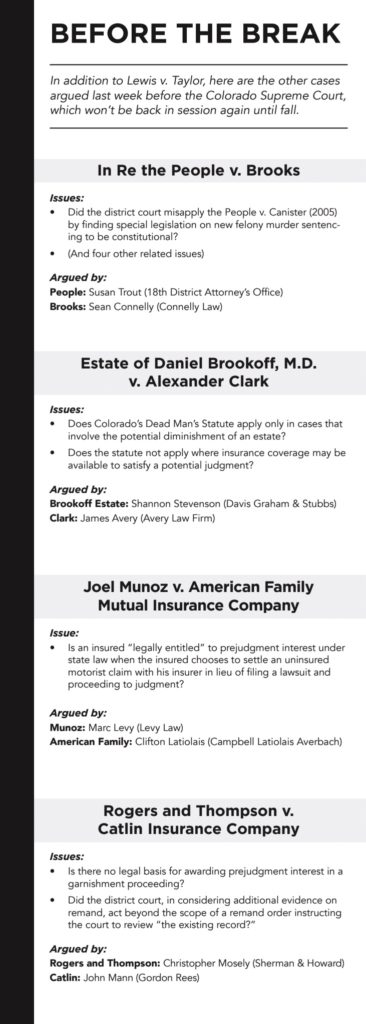
With its second look at C. Randel Lewis v. Steve Taylor, the Colorado Supreme Court gets to decide an issue of first impression.
On Wednesday, the court heard oral arguments to determine whether an innocent person who invested in a Ponzi scheme, but managed to profit from it, must forfeit those gains under state law. While both sides of Lewis v. Taylor agree that the investor is entitled to keeping the amount of his original investment, the plaintiff says the defendant’s “false profits” must be distributed among the rest of the scheme’s victims.
The issue turns on whether the transfer of the Ponzi scheme profits was void under Colorado Uniform Fraudulent Transfer Act. CUFTA nullifies fraudulent transfers, but it makes an exception if the investor was in good faith and gave something of “reasonably equivalent value.” The Colorado Court of Appeals opened the door for that exception in Lewis v. Taylor and remanded the case, but the state Supreme Court might decide differently.
In the mid-2000s, securities broker Sean Mueller ran a hedge fund that he used to defraud investors of more than $70 million. One of those investors, car dealership owner Steve Taylor, actually made money from the fund by investing $3 million in 2006 as an equity partner, then withdrawing all of his money the following year to realize a net profit of over $487,000. Despite Taylor’s ability to get his money back and then some, the fund was actually losing money and turned out to be insolvent.
After Mueller’s Ponzi scheme was discovered and he pleaded guilty to fraud, theft and racketeering, the district court appointed plaintiff C. Randel Lewis as a receiver who would liquidate and distribute Mueller’s assets among the fraud victims. As part of the recovery, Lewis made a CUFTA claim to void the transfer of Taylor’s profits from the fund.
Taylor maintained in district court that the statute of limitations had run on Lewis’ CUFTA claim, and even if it hadn’t, CUFTA didn’t require him to return his gains from the Ponzi scheme because he was an innocent investor. But the court granted summary judgment in Lewis’ favor.
In 2014, the Court of Appeals reversed the district court’s finding that Lewis’ claim was timely, but it didn’t touch the issue of whether Taylor had to forfeit his profits. But it would do so on a second appeal. The question before the court was whether Taylor could still keep profits based on the “time value of money.” Time value of money, or the value of giving money to someone else to use over a period, is the concept behind charging interest for a debt or a loan.
In February 2017, the Court of Appeals found time value to be applicable even to a Ponzi scheme situation. The appeals court held that the district court erred by ignoring the time value when deciding whether Taylor gave reasonably equivalent value for the transfers from Mueller’s fund.
“[A]ny evaluation of what constitutes reasonably equivalent value in this case must address what was actually exchanged, not how the hedge fund fraudulently used whatever it received in the exchange,” according to the panel’s opinion written by Judge Karen Ashby. “This evaluation cannot ignore the fact that there is value in the use of money for a period of time.”

At Wednesday’s arguments, Michael Gilbert, the attorney representing the plaintiff, said that investors are considered “creditors” under CUFTA, with the Ponzi scheme runner as the “debtor.” But payment of “false profits” to an equity investor, which Taylor was, doesn’t satisfy a debt, Gilbert argued; the investor has no claim against the Ponzi runner for false profits “so under CUFTA there’s no value.”
Justice Nathan Coats asked why Taylor should be allowed to recover his principal from the fraudulent fund, as the parties agree, yet not be allowed to recover the value of what the principal would be at the time he recovered it based on a time value calculation.
“The answer I think is different in a contract or debt case, where time value is the concept that underlies the initial obligation,” Gilbert replied. Prejudgment interest, for example, is meant to compensate someone for their money that was wrongfully withheld from them. But Taylor’s equity investment wasn’t wrongfully withheld because there was no guarantee he should ever get it back, Gilbert said.
“We have to deal with what we’re looking at … which is a limited partnership that lost money,” Gilbert said.
Taylor’s position is even if he can’t keep the nearly half million in profits he realized from the fund, he is entitled to some money above his principal based on time value of having parked the money in the fund for a little over a year, whatever that calculation turns out to be. Richard Podoll of Podoll Podoll argued that the $487,000, or the 16 percent profit Taylor withdrew from the fund, was the time value. Justice Brian Boatright pushed back on that idea, saying that return was based on the performance of what was a fraudulent fund.
“Aren’t you saying that his time value of money is really worth what he would have gotten on a CD or a reasonable investment or something?” Boatright asked. “The 16 percent is fictitious.”
“It’s not,” Podoll said. He cited expert reports showing that some hedge funds in that 2006-2007 period produced higher returns than that, granted the average was lower than 16 percent.
Justice Richard Gabriel pushed Taylor’s attorney on the plaintiff’s point, which is that an equity investment is different from a loan or contract. “You may get zero, you may lose all your money,” Gabriel said. “Doesn’t that distinction make sense?”
“The simple explanation is it’s all fake,” Podoll responded. “There was no equity investment here, there would have been no contract investment. It’s all a Ponzi scheme.” But Taylor did give something of value for his profits, “and the value he gave was the use of his money for over a year,” Podoll said.
— Doug Chartier

